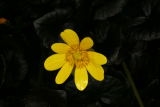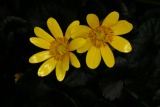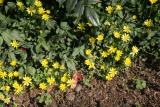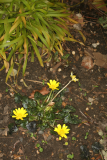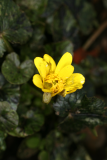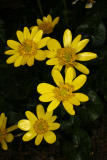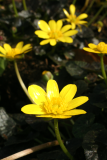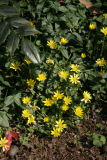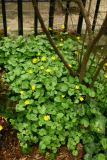Additional notes (click to expand)
Medicinal
Traditional Herbal Medicine Registration (THMR).
Carrying the roots, or applying a paste made from them, alleviated haemorrhoids/piles.
Lyte, Henry. (1578). Nievve Herball or Historie of Plantes.
Nomenclature
Other common names: crain, crow's foot, figwort, Kenningworth, marsh pilewort, pilewort and small celandine.
The Royal Horticultural Society Horticultural Database, available at www.rhs.org.uk
Known as Pilewort, and carrying the roots, or applying a paste made from them, alleviated haemorrhoids/piles, according to Culpeper. A medieval name for a haemorrhoid was ‘Fig’, and it is possible that the suffic ‘-aria’ signifies ‘belonging to’ as in ‘sectarian’, ‘vegetarian’, ‘parliamentarian’,
and that ‘ficaria’ means ‘pertaining to piles’.
Oakeley notes: May 2014
Synonym of Ranunculus ficaria
Plants of the World online, Kew Science http://www.plantsoftheworldonline.org/taxon/urn:lsid:ipni.org:names:712703-1
link
Other use
Ranunculus ficaria L. Ranunculaceae Lesser Celandine, Cultivar 'Brazen Hussy' Distribution: Europe. lesser celandine, pilewort and figwort: for piles. Carrying the roots, or applying a paste made from them, alleviated haemorrhoids/piles, according to Lyte. An early English name for a haemorrhoid was a ‘fig’ and ‘ficaria’ means ‘pertaining to piles’. Celandine is a corruption of the Greek word ‘chelidonion’, meaning a swallow, was said to flower when the swallows appeared and to wither away when they left, according to Lyte. However, Dioscorides attributes this phenomenon to our greater celandine, Chelidonium majus, which starts later and continues in flower until the autumn. Of course, in southern Italy the proverb is ‘One swallow does not make a spring’ as opposed to the English ‘One swallow does not make a summer’, and they appear earlier and leave even later in the land of Dioscorides. However, Ranunculus ficaria is no relation of Chelidonium majus. Plants in the buttercup family, Ranunculaceae, tend to be poisonous and are one of the few plants that thrive in alpine meadows when cows are present. The cows avoid them but eat almost all the other wild flowers.
Oakeley, Dr. Henry. (2011). A Year in the Medicinal Garden of the Royal College of Physicians, revised edition. Royal College of Physicians, London.
link
Toxicity
Plants in the buttercup family, Ranunculaceae, tend to be poisonous and are among
the few plants that thrive in alpine meadows when cows are present. The cows avoid them but eat almost all the other wild flowers.
Oakeley, Dr. Henry. (2011). A Year in the Medicinal Garden of the Royal College of Physicians, revised edition. Royal College of Physicians, London.
link
Geographical distribution
- Africa, Northern Africa, Algeria
- Africa, Northern Africa, Libya
- Africa, Northern Africa, Morocco
- Africa, Northern Africa, Tunisia
- Asia-Temperate
- Europe
Ficaria verna L.
Family: RANUNCULACEAEGenus: Ficaria
Species: verna L.
Common names: Lesser Celandine
Distribution summary: Europe, N. Africa, S.W. Asia
Habit: Perennial
Hardiness: H5 - Hardy; cold winter
Habitat: Moist woodland and riverbanks
Garden status: Not currently grown
Flowering months: March, April
Reason for growing: Medicinal

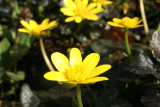

.JPG)
